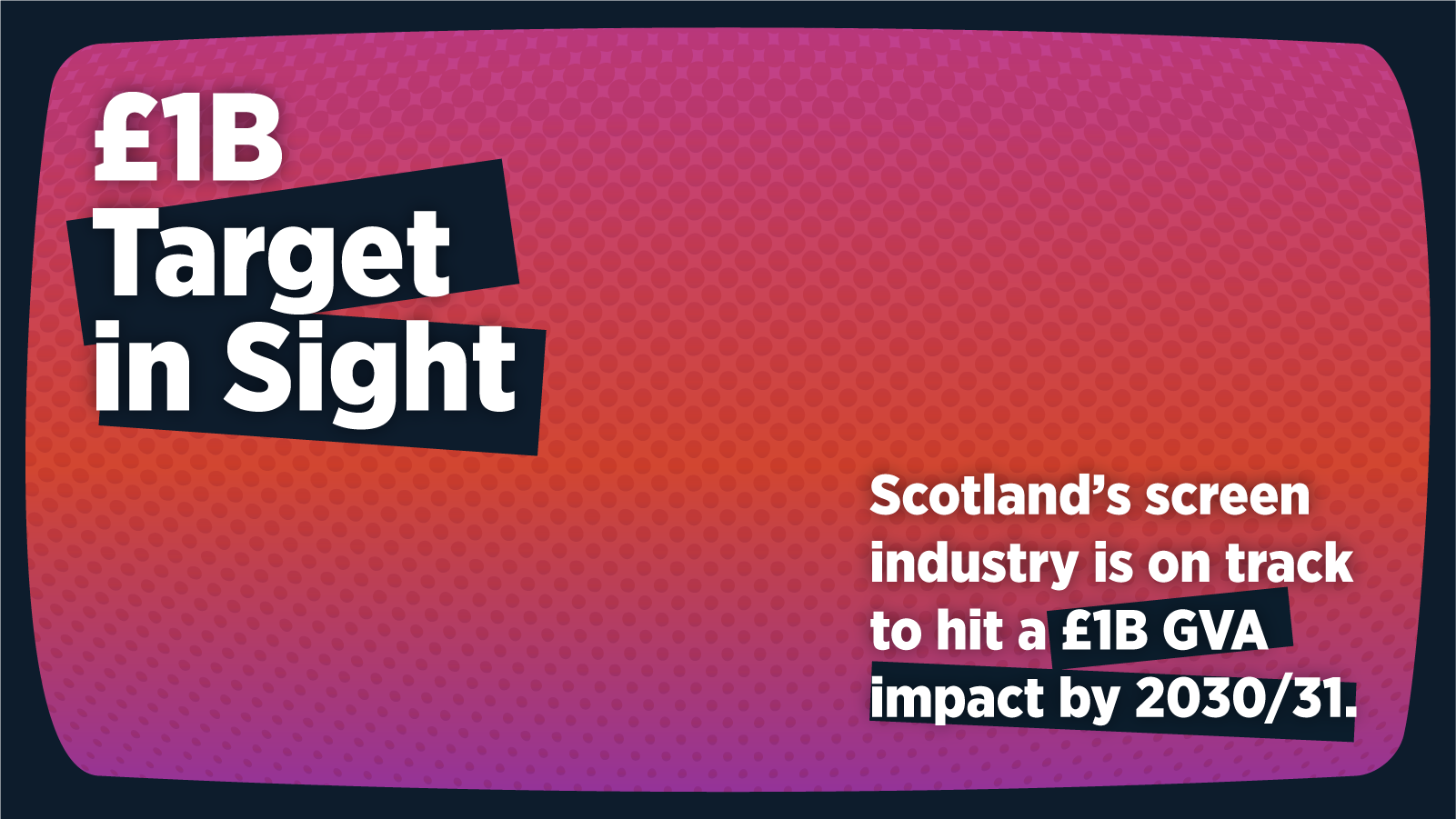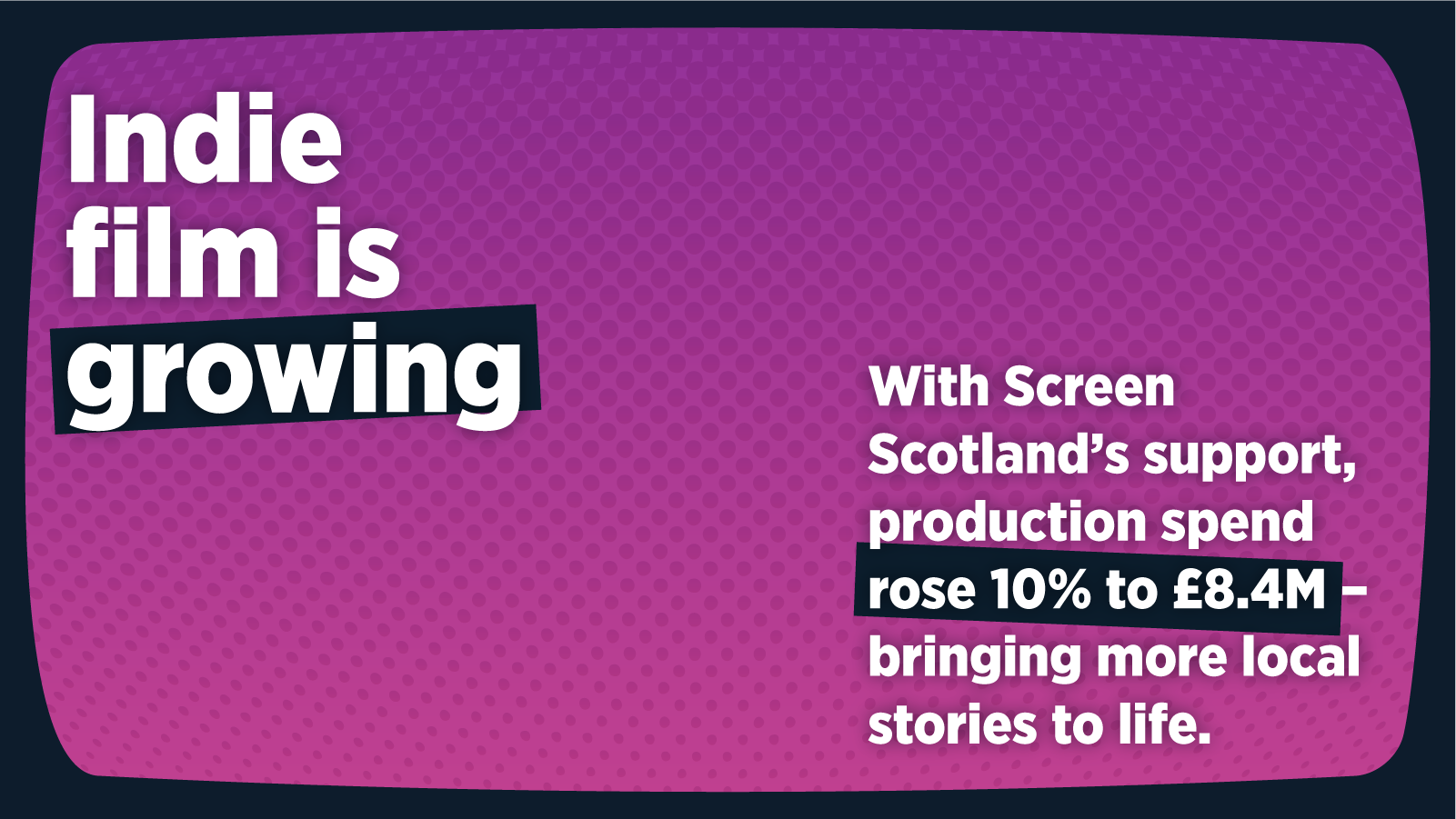Screen Scotland has published the latest figures detailing the screen sector’s impact within the Scottish economy. The research shows continued economic growth in Scotland’s film and television sector, and the value of sustained public investment in film and television production, cinema exhibition, screen education, talent and skills development.
Commissioned by Screen Scotland and produced by Saffery LLP and Nordicity, the independent report titled The Economic Value of the Screen Sector in Scotland in 2023 finds that the overall value of the sector continued to grow in 2023, with both cinemas and screen tourism rebounding as COVID restrictions were lifted.

This is despite 2023 being a challenging year for production globally, with industrial action from the US actors and writers' unions halting much film and high-end TV drama production across the second half of the year. Key findings show:
-
GVA in Scotland’s screen sector increased by 15%, from £627 million in 2021 to £718 million.
-
Employment in Scotland’s screen sector increased by 12.1% from 10,940 full-time equivalents (FTEs) in 2021 to 12,260 FTEs in 2023.
-
Having more than doubled between 2019 and 2021, inward investment film and HETV production in Scotland fell back to £173.5 million in 2023 in line with global trends, from £347 million in 2021, as a consequence of the US writers and actors strikes. Several projects of scale moved to a 2024 start of production. The level of spending in 2023 was still higher than the £165million recorded in 2019.
-
Indeed, and though not covered in detail in this report on 2023, Scotland’s inward film and HETV production enjoyed a very healthy recovery in the first half of 2024. Initial estimates of filming days in the first half of 2024 provided by Screen Scotland’s Screen Commission indicate that 17 films and TV series (including Netflix’s Department Q.) started principal photography in Scotland in the first six months of 2024, generating an estimated £194 million in total production spend and putting Scotland on course to realise up to £400 million in combined inward investment and independent film and TV production during the 2024 calendar year. This would be well above the combined £347 million record reached in 2021.
-
Nonetheless, 2023 inward investment spend remained well ahead of the 2019 baseline.
-
The recovery in cinema box office has been slightly faster in Scotland compared to the overall UK. In 2023, Scotland’s cinema box office (£79.9 million) had recovered to 80% of its 2019 level (£99.8 million), whereas across the entire UK, the cinema box office (£980 million) had recovered to 78% of its 2019 level (£1.254 million).
-
The PSBs – primarily the BBC and Channel 4 – remain the core source of demand, financing and commissioning of TV programmes and documentary films made by Scotland-based producers. The overall PSB spend figure for 2023 was £222.4million, almost identical to 2021’s £223.3million. This is of course a real terms decline in spend in a sector that has, like the rest of the economy, seen cost rises across the board.
-
Supported by Screen Scotland, independent film production spend rose by 10% to £8.4million in 2023 compared to £7.6million in 2021 although as for PSB funded content, in real terms this does not represent an increase.
GVA is the standard measure used by the Office for National Statistics (ONS) and other national statistical agencies for measuring the monetary value of economic activity and the economic performance of industries.
Read the full report now on our website.

Isabel Davis, Screen Scotland’s Executive Director said: “Scotland’s growth held up well in 2023, indicating that the strategy for building sustainable and year-round production through a mixed ecosystem remains on track. From today’s vantage point we also know that 2024 saw significant further growth that has continued across 2025. Challenges remain though; there is a worldwide downturn in unscripted commissioning and the migration of audiences to digital platforms such as YouTube offers both clear risks and new opportunities for legacy broadcasters and producers. Screen Scotland has always aimed to stay nimble, working with the grain of industry and audience trends. We see content creation as a key element in the future of Scotland’s screen sector, one capable of driving economic and creative gains for the country.
“Meanwhile, the contribution that film and TV makes to tourism into Scotland remains hugely significant and is to be celebrated. It shows the long-term return on investment we gain from projects such as Outlander. We’re equally delighted that audiences in Scotland have returned to cinemas faster than elsewhere in the UK.”
Authors of the Report, Stephen Bristow, Partner in the Film and TV team at Saffery, said: “The screen sector is an economic success story for the UK and nowhere more so than in Scotland. The industry has had to navigate ongoing challenges, not least including the impact of the Hollywood strikes - which displaced some of 2023’s planned investment into 2024. But with employment and GVA up in 2023, and inward production investment having shown marked signs of recovery in 2024, the Scottish screen sector is going from strength to strength.
“The Westminster government has signalled its support for the industry with its Creative Industries sector plan, which recognised Scotland’s position as a dynamic hub of creative talent and economic potential, and has continued to show commitment to the UK’s globally leading range of tax reliefs and incentives; these deliver huge value for both taxpayers and the production industry across all corners of the UK – including Scotland.
“Taken together with an expanding production base and a highly skilled workforce, Scotland is well positioned to hit Screen Scotland’s target for the sector to add £1billion of economic value by 2030/31."
Culture Secretary Angus Robertson said: “I welcome this report, which shows that Scotland’s screen sector is on track to reach our shared goal of £1 billion Gross Value Added to the Scottish economy by 2030.
“With Screen Scotland’s industry expertise on hand for productions, as well as our skilled crews and stunning locations, Scotland continues to be a draw for international investment, and a nurturing environment for home-grown talent.
“I am also pleased to see the report highlight the importance of cinemas, and screen tourism, to the sector, clearly demonstrating the vital role in film and television in our cultural lives.”
More information
* Productions shooting in studios and on location in Scotland in 2023 included: Danny Boyle’s 28 Years Later, Netflix’s The Diplomat series 2, Prime Video’s Fear, Starz’s Outlander, BBC and Euston Films’ Nightsleeper, Vigil series 2 from BBC and World Productions, Shetland, the BBC’s revamped Rebus, Dinosaur, Harvest, On Falling, The Fall of Sir Douglas Weatherford, Screw series 2, Belgravia: The Next Chapter, The Crown series 6, Starz Original series Mary and George, Samuel L Jackson led film Damaged, Tish, Celluloid Underground, Loch Ness: They Created A Monster, A Bear Named Wojtek, Mogwai: If the Stars Had a Sound.
** According to the British Film Institute (BFI), the combined value of spending on the production of films and high-end TV programmes across the UK grew at an annual average rate of 28.8% between 2013 and 2022 and reached a record £7.5 billion in that year.
*** GVA figure has been rounded to its nearest percentage point.
1. Screen Scotland commissioned international consultancies Saffery and Nordicity to prepare a full-scale economic impact study to assess the value of the Scottish screen sector, its sub-sectors and activities, and linkages to and influences on wider economic activity across Scotland.
2. The work was undertaken with the support of industry partners including the BFI, ONS, Ofcom, public service broadcasters (PSBs) and VisitScotland.
3. The purpose of the study was to determine the full impact of the Scottish Government’s investment in the screen sector, against the consistent method of data collection established in the initial 2019 study, highlighting the sector’s development and progress against targets, tracking back to a clear baseline.
4. The screen sector has been defined as inclusive of film and TV development and production, animation, VFX and post-production, film and TV distribution, TV broadcast, film exhibition, film and TV skills and education, and film and TV production facilities. The study covers film, TV and other audio-visual content; it does not cover the video games sector, nor does it include all of the commercials/corporate sector or online video production. In that regard, the report focuses on film and TV that is intended for initial release in cinemas, on broadcast or multichannel TV or related catch-up services, or subscription video on demand (SVOD) services.
5. The study draws upon a variety of different sources – the Annual Business Survey (ABS), other data from the Office for National Statistics (ONS), BFI, Ofcom, Companies House filings and D&B Hoovers, industry surveys and interviews – to provide a comprehensive estimate of the contribution that the entire screen sector value chain and its spillover impacts – particularly screen tourism and screen education and skills development – make to Scotland’s economy.